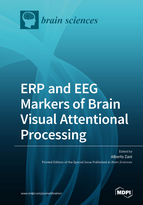ERP and EEG Markers of Brain Visual Attentional Processing
A special issue of Brain Sciences (ISSN 2076-3425).
Deadline for manuscript submissions: closed (30 September 2019) | Viewed by 44472
Special Issue Editor
Interests: ERPs; EEG bands; visual attention; attentional neural networks; attentional sensory modulation
Special Issue Information
Dear Colleagues,
Brain Sciences is seeking submissions for a forthcoming Special Issue entitled “ERP and EEG Markers of Brain Visual Attentional Processing”.
Visual attention includes a multifaceted pool of cognitive and perceptual functions (dividing, switching, orienting, searching and sustaining) allowing privileged processing of relevant information and concurrent filtering of irrelevant inputs. This applies to both space and object processing and involves both the anterior and posterior attentional systems.
These functions are associated with a modulation of alpha, beta, theta and gamma EEG oscillations, and affect ERP components both at the earliest (C1-C2 or PN/80 levels) and later latencies (P1, N1, N2pc or P300 levels). These alterations result in beneficial cognitive and behavioral effects. However, the functions of EEG bands and ERP components, as well as the latency and brain locations at which attention affects these indicants, are still debated topics.
This Special Issue aims to contribute to this debate and to take a fresh look at how brain EEG and ERP waves help enable visual attention.
We invite investigators to contribute articles that will add precious insights into the neural mechanisms of visual attention. Studies describing these mechanisms in healthy individuals and psychiatric patients of different ages as compared with animal research are also welcomed.
Potential topics include, but are not limited to:
EEG and ERP waves and their neural generators (hemodynamic, MEG/neuroimaging or source reconstruction data). Possible themes include: Spatial attention, object-based attention to shapes, faces, scenes, gestures, actions, words, spatial frequency, orientation, color, and illusory contours.
Dr. Alberto Zani
Guest Editor
Manuscript Submission Information
Manuscripts should be submitted online at www.mdpi.com by registering and logging in to this website. Once you are registered, click here to go to the submission form. Manuscripts can be submitted until the deadline. All submissions that pass pre-check are peer-reviewed. Accepted papers will be published continuously in the journal (as soon as accepted) and will be listed together on the special issue website. Research articles, review articles as well as short communications are invited. For planned papers, a title and short abstract (about 100 words) can be sent to the Editorial Office for announcement on this website.
Submitted manuscripts should not have been published previously, nor be under consideration for publication elsewhere (except conference proceedings papers). All manuscripts are thoroughly refereed through a single-blind peer-review process. A guide for authors and other relevant information for submission of manuscripts is available on the Instructions for Authors page. Brain Sciences is an international peer-reviewed open access monthly journal published by MDPI.
Please visit the Instructions for Authors page before submitting a manuscript. The Article Processing Charge (APC) for publication in this open access journal is 2200 CHF (Swiss Francs). Submitted papers should be well formatted and use good English. Authors may use MDPI's English editing service prior to publication or during author revisions.
Keywords
- ERPs
- EEG bands
- Visual attentional processing
- Brain attentional networks







